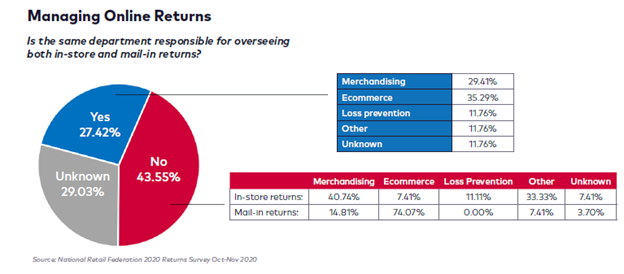Executive Overview
If your company doesn’t already have an executive with overarching power to be in charge of the entire returns experience, you’re not alone. Very few do despite the important role the return experience plays in the consumer journey, inventory management, store operations, and asset protection. As a result, your company may miss out on ways to improve relationships with your consumers, experience higher overhead cost, and retain less revenue in multiple departments and channels. The gaps in consumer service may degrade the CX. Continue reading this article to understand the scope of the situation today and the improvements that may be achieved by identifying an executive to manage all facets of returns.
Everyone’s Problem and Nobody’s Responsibility
Retail companies spread the responsibilities for retail returns among different groups as shown in our 2020 Consumer Returns in the Retail Industry Report, developed in conjunction with the National Retail Federation. Some companies determine who is responsible for the return based on channel. Surprisingly, in almost one third of all companies, the responsibility is unknown!

Our experience shows that while each department seeks the same macro goals—please consumers and keep revenue high—each seeks different immediate outcomes. It depends on their perspective. Asset Protection, for instance, seeks to reduce fraud, loss, and risk; Merchandising tries to reduce overstock/out-of-stock situations that cause loss; Ecommerce may handle its own risk situations and ship-from-store scenarios for returned merchandise used in BORIS transactions. While departmental paths may cross, their efforts are not always coordinated. Without transparency, the risk of loss increases.
The underlying issue is part of the fundamental design of retailer organizations. Retailers designed their workflows to move merchandise smoothly from suppliers to consumers as well as to and from stores. They spend a great deal of money and time to make the process as efficient and frictionless as possible. Unfortunately, returns flow the opposite direction, adding complexity that multiplies with every channel involved. For example, traditionally returns came from in-store purchases, but now consumers can buy-online-return in-store (BORIS), buy-online-return-online (BORO), or any number of other options. Individual departments address these issues as best they can, but their scope and authority are limited.
Returns are also a personal—sometimes emotional—point in the consumer journey. How the retailer responds impacts future loyalty and sales.
Lack of coordination under one executive can lead to several problems, including:
- No master plan for the entire consumer journey
- In-store
- Online
- Omnichannel
- Missed consumer loyalty opportunities
- No standardized measurement
- Duplicated effort
- Increased shrink
- Hidden product quality issues
- Unaddressed product information gaps (both online and in-store)
Department heads may negotiate to resolve cross-departmental issues, but these negotiations may be too slow to allow a nimble response to changes within the organization or in the marketplace that would impact consumer shopping choices.
What Opportunities Does Having an Executive in Charge of Returns Open Up?
The executive in charge of returns cuts through the bureaucracy created when one issue affects multiple departments within the company. Although returns are a cost of doing business, they are a cost the retailer can plan for and influence. Returns are also a personal—sometimes emotional—point in the consumer journey. How the retailer responds impacts future loyalty and sales.
For every $1 billion in sales the retailer can expect to experience $106 million in merchandise returns overall, but for ecommerce purchases it jumps to $180 million! A modest 8% reduction in return volume alone could preserve $8-14 million per $1 billion respectively.
HOW BIG IS THE OPPORTUNITY?
The worldwide cost of returns exceeded $1 trillion according to IHL Research. In the US, according to the National Retail Federation, US retail returns reached $428 billion in 2020. The average return rate in that study reaches an average of 10.6% from all channels and, more specifically, 18% from ecommerce. For every $1 billion in sales the retailer can expect to experience $106 million in merchandise returns overall, but for ecommerce purchases it jumps to $180 million! A modest 8% reduction in return volume alone could preserve $8-14 million per $1 billion respectively. Along with retaining that level of revenue, the executive can impact cost and omnichannel.
Therefore, the executive in charge of returns shouldn’t try to eliminate all returns—they are too important from a consumer relationship standpoint as well as for brand management. The executive could, however, seek to reach an optimal return rate in which consumers are confident and the business retains its sales. (You’ll find an explanation of how to calculate the optimal return rate here.) The optimal rate will likely be several percentages below the retailer’s average.
ELEVATED CONSUMER EXPERIENCE
Through Google you can find many studies showing that consumers consider a retailer’s return policy before making a purchase. An executive in charge of the returns experience could design policies that offer consumers the confidence they need to make a purchase. When a return is necessary, the executive in charge of the returns experience could engineer a smooth process regardless of channel.
This is particularly important because our research shows that the loyal consumers who spend the most also make the most legitimate returns. This is the exact audience retailers want to attract and to learn more about. Finding out the reasons for returns within this crucial group could influence decisions the retailer makes about policies, products, and vendors.
INCREASED REVENUE
A consumer initiates a return by reaching out to the retailer. How the retailer treats this engagement can strongly influence the likelihood of the consumer making a future purchase. The executive in charge of the returns experience could use the return as an opportunity to offer new purchase incentives, promote specific brands, and increase basket size.
IMPROVED OMNICHANNEL PROCESSES
Returns can be operationally complex, particularly for omnichannel retailers. An executive in charge of returns would bridge the siloes of information to develop a master plan for merchandise handling and disposition. This could reduce duplicated effort, better manage handling costs, and help move the needle on sustainability goals.
REDUCED SHRINK
Return risk takes many forms and costs US retailers billions of dollars. In 2020, every $100 in goods retailers accepted as returns cost them $5.90 in return loss. An executive in charge of returns could work with Asset Protection to select the software that could help reduce this startling number.
Summary
To satisfy consumers, retailers offer many ways to make returns. Omnichannel retailers in particular struggle with the complexity of enforcing policies uniformly, creating a frictionless process, and satisfying the loyal consumers who make frequent returns. An executive in charge of returns can develop a clear view of the returns processes and streamline them. This individual can identify areas where losses are high as well as areas where returns can convert into revenue. Consumer loyalty and spending depend on the returns experience, and the executive in charge of returns could own that opportunity.





